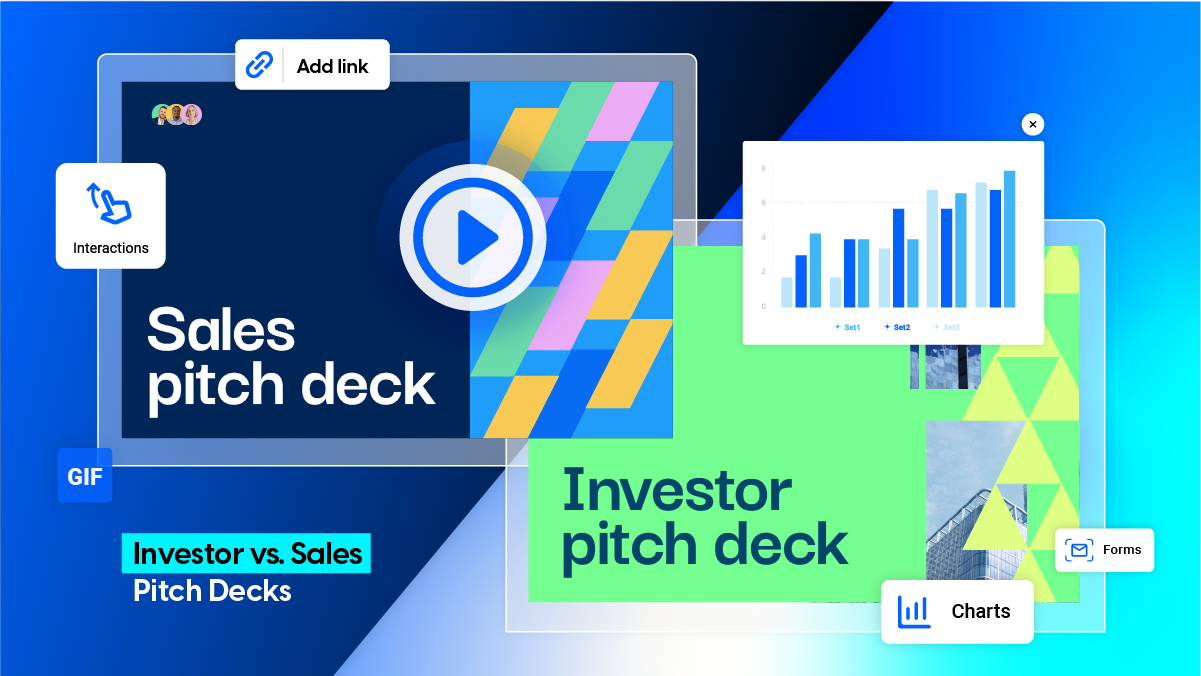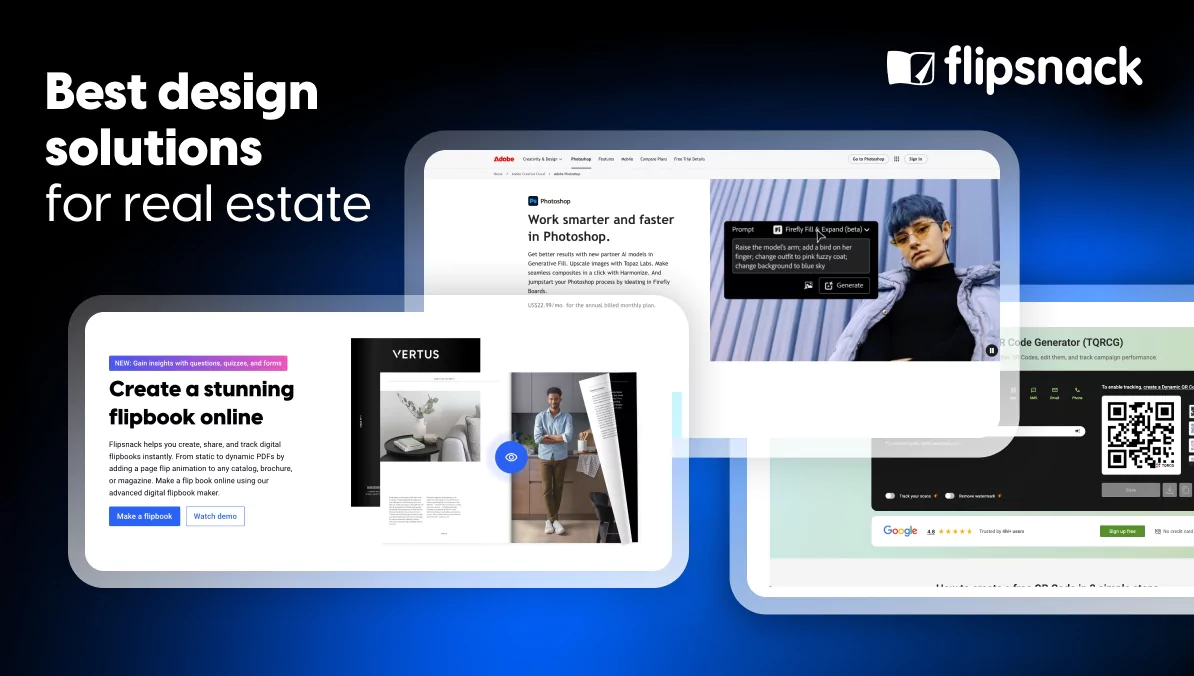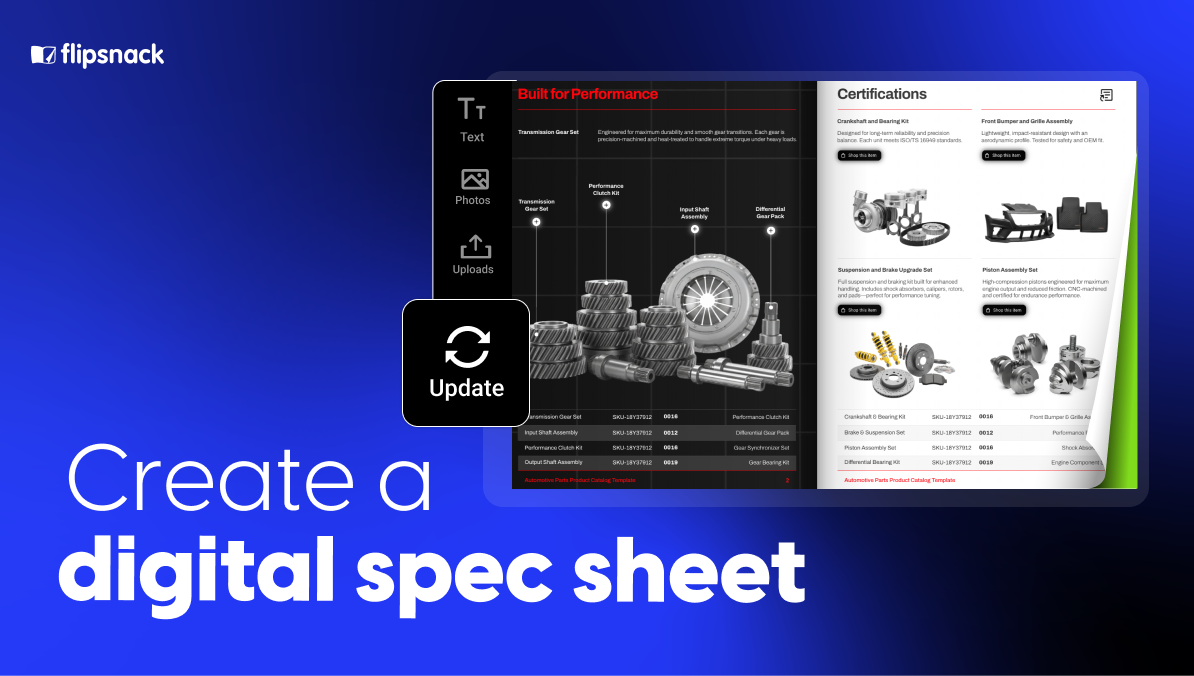Investor vs. Sales Pitch Decks: What’s the difference and how to customize each
A pitch deck is more than just a collection of slides—it’s a powerful tool for storytelling, persuasion, and business growth. But not all pitch decks serve the same purpose. If you’ve ever used the same deck for investors and potential clients, you might be missing opportunities to secure funding, close deals faster, and make a stronger impact.
Understanding the differences between investor and sales pitch decks is key to crafting a message that resonates. Investor decks focus on market potential, business models, and financial projections—what investors need to make informed funding decisions. Sales decks, on the other hand, are all about the customer: solving pain points, demonstrating value, and guiding prospects toward a purchase decision.
This guide breaks down the best practices for pitch deck design and structure and shows you how to tailor a pitch deck for different audiences—so you can pitch with confidence, whether you’re seeking investment or driving revenue. Plus, if you want to streamline your pitch deck creation and design, we’ll show you how Flipsnack’s interactive pitch deck maker will make the process faster, easier, and more effective.
Let’s get started.
What is a pitch deck?
A pitch deck is a short, visual presentation that explains a business idea, product, or opportunity. It’s used to attract investors, clients, or strategic partners by showcasing key aspects like the business model, market opportunity, and financial projections. A well-structured pitch deck helps decision-makers quickly grasp the value and potential of a business.

The importance of pitch decks in fundraising and sales
For fundraising, a compelling pitch deck is essential. It helps entrepreneurs secure investment by clearly outlining their vision, strategy, and growth potential. Investors need concise, data-driven presentations that highlight market demand, financial performance, and competitive advantage.
In sales, a pitch deck serves as a persuasive tool to convert potential clients. It demonstrates how a product or service solves specific pain points and why it stands out from competitors. A well-crafted sales deck can speed up decision-making and improve close rates.
Investor vs. Sales Pitch Deck: Key differences
An investor pitch deck is a presentation designed to secure funding by showcasing a company’s market potential, business model, and financial projections. It targets investors and venture capitalists looking for high-growth opportunities. A sales pitch deck is a presentation used to sell a product or service by highlighting customer pain points, value propositions, and real-world benefits. It is aimed at potential clients to drive conversions and close deals.
The key difference is that investor decks focus on financial potential and long-term growth, while sales decks emphasize product value and customer solutions.
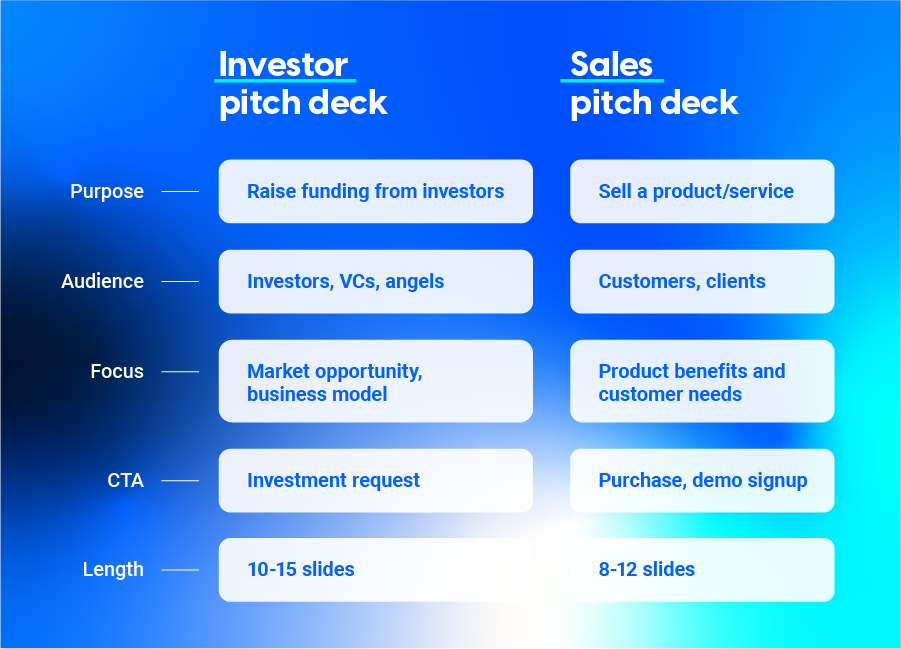
Investor Pitch Deck: Definition, purpose, and key components
An effective investor pitch deck must do more than just showcase an idea—it needs to convince investors that the business is worth funding. The presentation should establish credibility, demonstrate scalability, and highlight potential returns. Investors want to see proof that the company has a viable market, competitive positioning, and a solid revenue model.
Beyond numbers, a pitch deck should tell a compelling story, showing how the business solves a pressing problem, gains traction, and scales efficiently. The ultimate goal is to secure funding by presenting a clear, data-backed investment opportunity.
An effective investor pitch deck highlights a clear problem, demonstrates market demand, and presents a scalable revenue model. Investors expect competitive analysis, traction metrics, and financial projections that show sustainable growth. The funding ask must be direct, outlining how the investment will drive business success.
With Flipsnack, you can create interactive investor decks with embedded charts, in-depth analytics, and professional visuals, ensuring your pitch stands out and delivers results.
Discover this professional investor pitch deck example created with Flipsnack. Browse through it to see the key elements and structure that make a pitch deck polished, persuasive, and effective for securing investor interest.
Sales Pitch Deck: Definition, purpose, and key components
A sales pitch deck, on the other hand, highlights product value, customer pain points, and real-world use cases. Instead of financial metrics, it emphasizes how the solution improves efficiency, reduces costs, or drives revenue for the customer. A strong sales deck uses engaging visuals, testimonials, and case studies to build trust and drive action. While an investor deck sells a business opportunity, a sales deck sells a solution to a problem. Both require compelling storytelling but serve entirely different decision-making processes. For teams that want to simplify and scale this process, Prezent’s platform for sales presentations helps create compelling, brand-aligned decks tailored to different audiences.
A strong sales pitch deck starts with a problem statement, outlining the key challenge the target audience faces. It then introduces the unique value proposition (UVP), explaining how the product provides a better solution than competitors. Product demos and screenshots bring the offering to life, showing how it works in real-world scenarios.
To build trust, a sales deck should include customer testimonials or case studies demonstrating proven success. Pricing and offer details help potential clients understand what they’re getting and why it’s worth the investment. A clear and persuasive call-to-action (CTA) ensures that prospects know precisely what to do next, whether it’s booking a meeting, requesting a demo, or starting a free trial.
Here’s a professional sales pitch deck template example created with Flipsnack, designed to help you craft compelling presentations that drive business growth and close deals effectively.
How to customize your pitch deck for maximum impact
A great pitch deck isn’t just about good design—it’s about delivering the right message to the right audience. Whether you’re pitching to investors or potential customers, customization is key. Investors want data, scalability, and financial viability, while buyers care about solutions, ROI, and usability. Tailoring your presentation ensures your audience gets exactly what they need to make a decision.
With Flipsnack, you can take customization further by adding interactive elements, real-time data, and seamless sharing options to make your pitch decks more engaging.
Let’s break down how to create an investor pitch deck and a winning sales pitch deck that drives results.
Investor pitch deck customization tips
An investor pitch deck needs to be clear, compelling, and backed by data. Investors don’t just want a great idea—they want proof of market demand, scalability, and profitability.
Here’s how to optimize your investor pitch deck for success:
1. Keep it data-driven and numbers-focused
Investors are drawn to hard facts, not fluff. Use financial projections, market growth statistics, and revenue models to validate your business potential. With Flipsnack, you can connect your Google Sheets, and it will automatically create charts based on your data—no extra work needed! Make complex data easy to understand, keeping investors engaged. Select from lines, bars, and pie charts to represent data impactfully.
In our intuitive Design Studio, every action happens with a simple drag-and-drop. Users can embed their data-based Google spreadsheet into the online pitch deck presentation with an engaging pop-up frame.
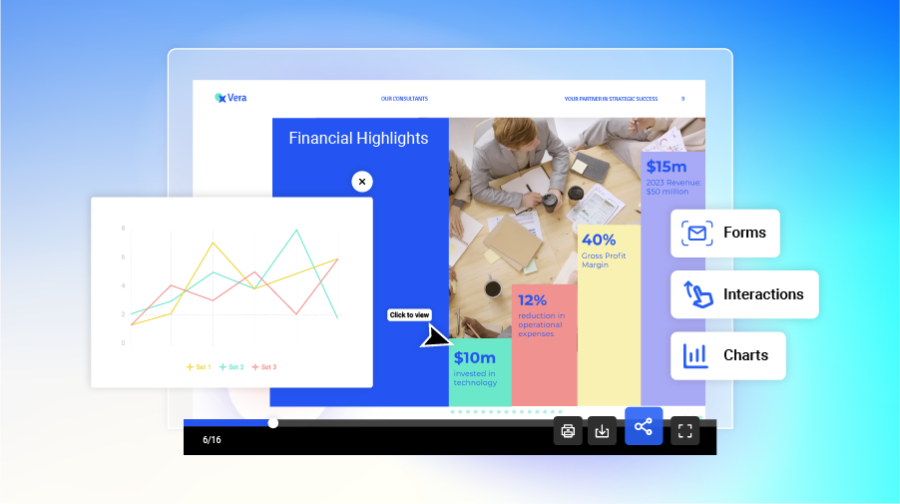
2. Use storytelling and engaging visuals
Numbers matter, but narrative sells. A strong investor pitch deck should tell a growth story, from identifying a problem to demonstrating traction. Add videos, high-quality images, photo slideshows, and animations to make your message more compelling.
3. Leverage Flipsnack’s interactive features
Make your investor deck stand out with interactive features like clickable elements and embedded forms to collect investor interest. With Flipsnack’s Zapier integration, you can automate lead transfer to your CRM, ensuring you never lose a potential investor’s contact.
4. Seamless sharing and distribution
Investors are busy. Make it easy for them to view, download, or share your pitch deck With Flipsnack, you can share publications privately with secure password-protected links or share via email only with specific people. We also have public sharing options like the possibility to embed your pitch deck directly on your website, or generate trackable links to monitor investor engagement.
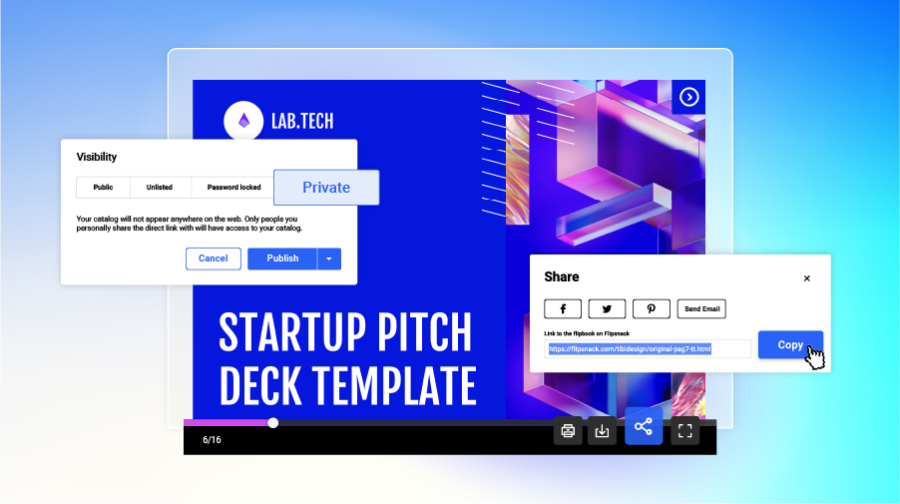
Sales pitch deck customization tips
A sales pitch deck needs to do one thing well: convince potential customers to take action. Here’s how to craft a winning sales pitch deck that closes deals faster:
1. Focus on customer pain points and solutions
Buyers don’t care about your company’s history; they care about how you can solve their problems. Structure your pitch deck around the challenges your audience faces and demonstrate how your product delivers results.
2. Use customer testimonials and case studies
Including success stories, testimonials, or before-and-after comparisons builds trust. With Flipsnack, you can create interactive sales pitch decks with real customer stories or embed testimonial videos directly in your deck.
3. Enhance engagement with Flipsnack’s interactive features
Flipsnack enables you to create dynamic, interactive sales pitch decks that captivate prospects and accelerate conversions. Integrate videos, animations, and product catalogs, and add a shopping list to deliver an engaging, hands-on experience.
4. Flipsnack’s branding and collaboration features
With Flipsnack, your team can create customized, on-brand pitch decks featuring your company’s logo, colors, and typography for a polished, professional presentation. Also, real-time collaboration keeps sales and marketing teams aligned, making updates seamless and efficient.
Flipsnack empowers organizations to create workspaces, manage projects, invite teammates, and assign different roles. Boost productivity with faster, more efficient communication—no lengthy meetings or excess emails.
5. Track and optimize your sales decks with analytics
Understanding which slides capture the most engagement is critical for refining your sales strategy. Flipsnack’s advanced analytics provide detailed metrics on views, clicks, and time spent on each slide, giving sales teams the insights they need to optimize messaging and presentation flow.
With Flipsnack, you’re not just building a pitch deck—you’re creating an interactive, data-driven sales or investor presentation that can be tracked, optimized, and shared effortlessly.
Common mistakes to avoid when creating pitch decks
A great pitch deck should be clear, engaging, and persuasive. However, common mistakes can undermine even the strongest business ideas. Here are some key pitfalls to avoid:
1. Overloading slides with text
Investors and clients don’t have time to read long paragraphs. Keep slides concise, visual, and easy to scan. Focus on key insights, compelling data, and impactful storytelling to maintain audience engagement.
2. Lacking a clear Call to Action (CTA)
Your audience should know exactly what to do next. Investor pitch decks should outline the funding request and its purpose, while sales pitch decks should drive prospects to take action—whether scheduling a demo, requesting a quote, or making a purchase.
3. Not customizing for your audience
Investors prioritize market size, revenue potential, and financial projections, while buyers want to see how your product solves their pain points. Tailoring your pitch deck ensures it resonates with the right audience.
4. Using low-quality design
Poor visuals, cluttered slides, and inconsistent branding can make your business look unprofessional. High-quality, polished designs create a strong impression and boost credibility.
By avoiding these mistakes, your pitch deck will be more engaging, effective, and likely to convert.
Where does Flipsnack fit into your pitch deck strategy?
Effectively communicating your business’s value starts with using the right pitch deck for the right audience. The difference between investor pitch decks and sales pitch decks lies in their purpose and focus. Investor decks emphasize financial potential, market opportunity, and scalability, appealing to venture capitalists and funding partners. In contrast, sales decks are built to address customer pain points, showcase product benefits, and drive conversions, ensuring prospects see the immediate value of your solution.

Customization is critical to making your pitch resonate. Investors expect data-driven insights and financial projections, while buyers need compelling product demonstrations and customer testimonials. With Flipsnack, you can build, refine, and tailor multiple versions of your pitch deck—all while maintaining brand consistency, interactive engagement, and seamless collaboration. Whether securing funding or closing a deal, Flipsnack helps you create high-impact, conversion-focused presentations that move decision-makers forward.
